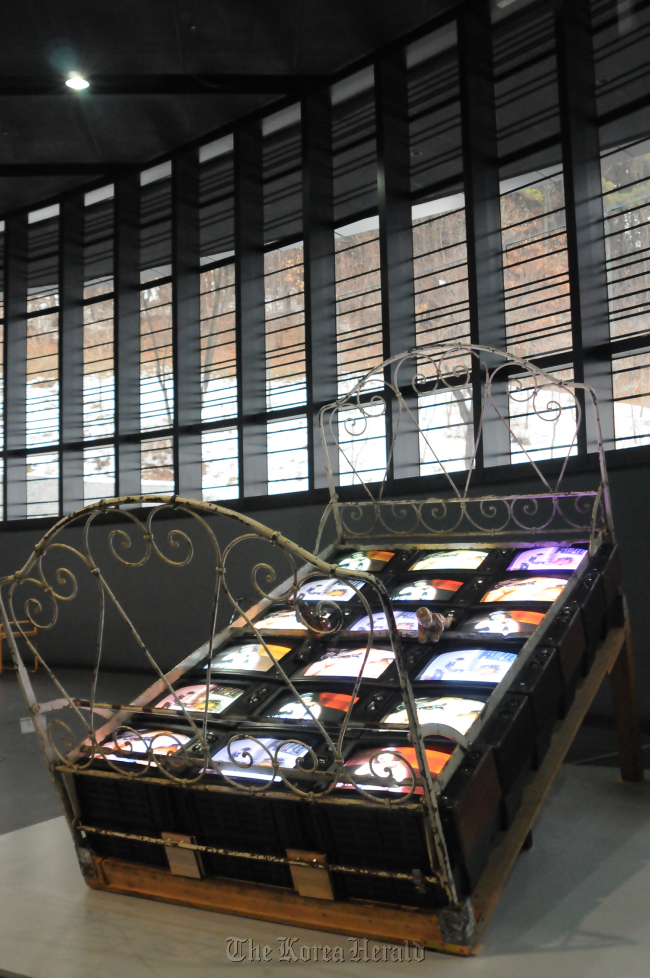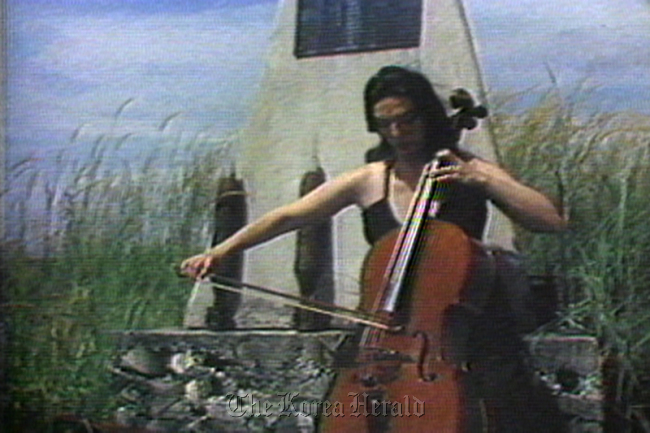Nam June Paik’s defiance of social order
New exhibition at Nam June Paik Art Center shows the artist’s artworks with political and social voice
By Lee Woo-youngPublished : Feb. 12, 2013 - 20:28

Nam June Paik has been called the father of video art, having transformed video into an art medium. But Paik didn’t limit his creations to video art. He explored diverse fields such as performance, collaboration, music and writing to present his ideas.
Through diverse media, Paik created symbolic performances that challenged social taboos and raised controversy in a conservative society.
The new exhibition at the Nam June Paik Art Center sheds light on Paik’s political and ideological side, as well as his attempt to bring about various social and political changes in the 1960s and 1970s.
Titled “Gentle Disturbance ― Talking Paik,” the exhibition features some of Paik’s artworks with political content such as the 1977 “Guadalcanal Requiem,” and the sensational nude performance “Opera Sextronique” in 1967.
“People know little about Paik’s ideological and political side. He has been well known to Korean people with his video installation works since the 1990s, but not with his other works,” said Lee Yoo-jin, the curator of the new exhibition, at a guided press tour last week.
Paik frequently incorporated music into his video works to create symbolic performances that challenged political and social issues.
Through diverse media, Paik created symbolic performances that challenged social taboos and raised controversy in a conservative society.
The new exhibition at the Nam June Paik Art Center sheds light on Paik’s political and ideological side, as well as his attempt to bring about various social and political changes in the 1960s and 1970s.
Titled “Gentle Disturbance ― Talking Paik,” the exhibition features some of Paik’s artworks with political content such as the 1977 “Guadalcanal Requiem,” and the sensational nude performance “Opera Sextronique” in 1967.
“People know little about Paik’s ideological and political side. He has been well known to Korean people with his video installation works since the 1990s, but not with his other works,” said Lee Yoo-jin, the curator of the new exhibition, at a guided press tour last week.
Paik frequently incorporated music into his video works to create symbolic performances that challenged political and social issues.

The 59-minute video “Guadalcanal Requiem” calls attention to the memory and trauma of war. Shot in the Guadalcanal on the Solomon Islands, a strategic point during World War II, the video features cello performances by Charlotte Moorman, a member of the Fluxus Movement founded in 1960 that mixes various artistic disciplines, and shamanic performance to comfort the souls of the war dead.
Another performance in the film presents an interesting scene in which the residents of the islands are introduced to television through the monitors attached to Moorman’s bra.
“Paik and Moorman used to say that ‘music is mass transit, so is the bra’ to describe their avant-garde performances,” said Lee.
Through controversial performances involving nudity and sexuality, Paik challenged social taboos.
In “Opera Sextronique,” Paik focused on the fact that sex is prohibited in music while it is frequently dealt with in art and literature.
However, his first attempt failed when Moorman was arrested by the police as she was playing cello topless in the second movement of the performance. The incident caused much controversy in the U.S. and earned Paik the label “cultural terrorist.” The performance was restaged at Carnegie Hall ten years later, in 1977.
The video shown in the exhibition features four acts edited for a general audience. The original film features Moorman playing cello wearing a light-bulb bikini, taking it off while making symbolic gestures and changing the instrument from cello to bomb in the last stage.
Ten contemporary Korean and foreign artists pay tribute to Paik’s legacy of challenging the social order through their own socially conscious works.
Starting with Korean artist duo Mix rice, who deal with migration, the exhibition leads the viewers to examine how art reflects social problems.
The “Tireless Refrain” section exhibits French artist Melik Ohanian’s exploration of lives of laborers in Sharjah in the United Arab Emirates; Spanish artist Santiago Sierra’s unusual test to reveal the nature of capitalism; Belgian artist Francis Alys’ observation of conflict between Israel and neighboring countries following the demarcation lines carrying a bottle of green paint; and Tunisian artist Nadia Kaabi-Linke’s satirical performances on U.K. immigration authorities.
The “Gentle Disturbance ― Talking Paik” continues through June 30 on the first floor of the art center and “Tireless Refrain” runs through June 16 on the second floor.
For more information, call (031) 201-8500.
By Lee Woo-young (wylee@heraldcorp.com)

















![[Herald Interview] Byun Yo-han's 'unlikable' character is result of calculated acting](http://res.heraldm.com/phpwas/restmb_idxmake.php?idx=652&simg=/content/image/2024/05/16/20240516050855_0.jpg&u=)
